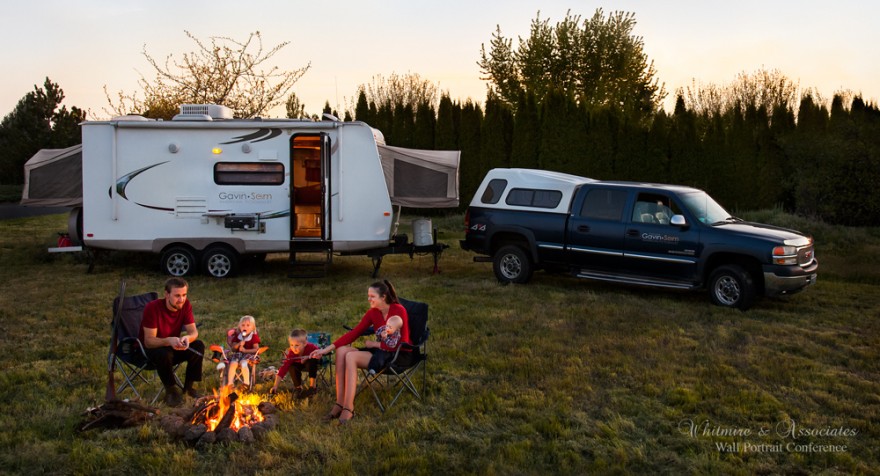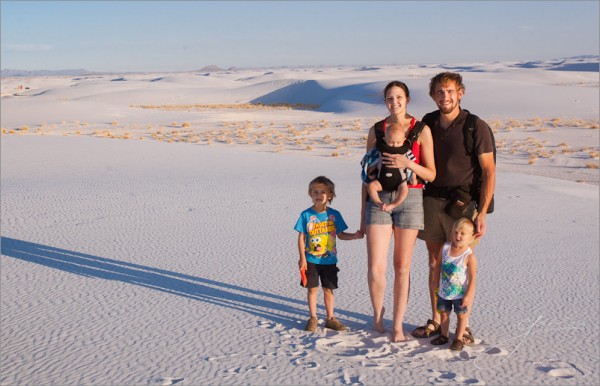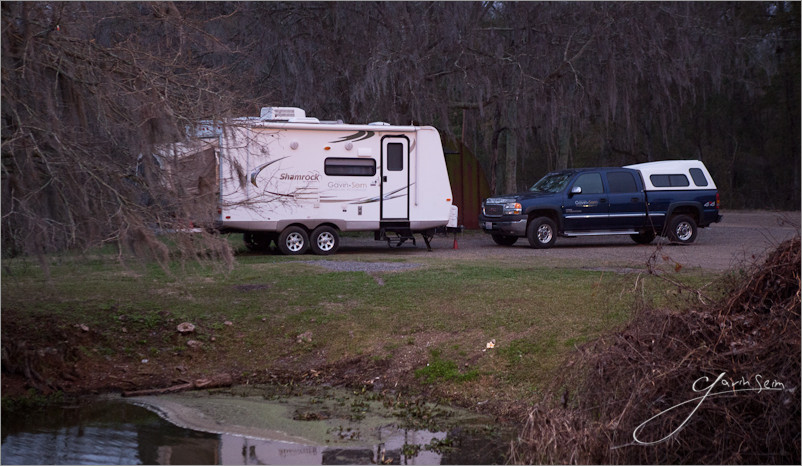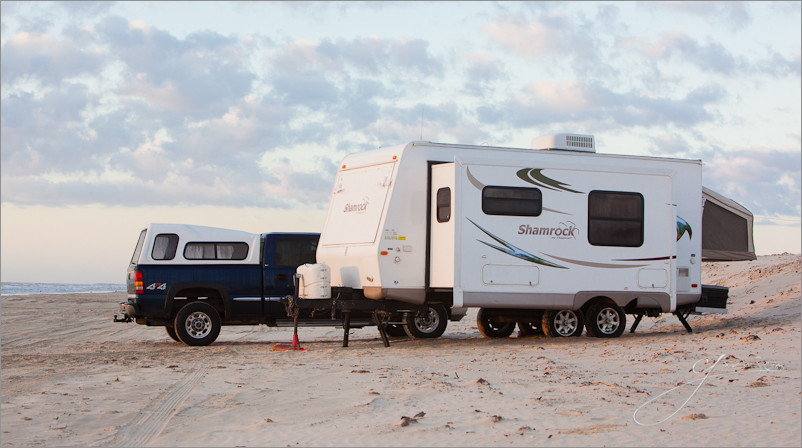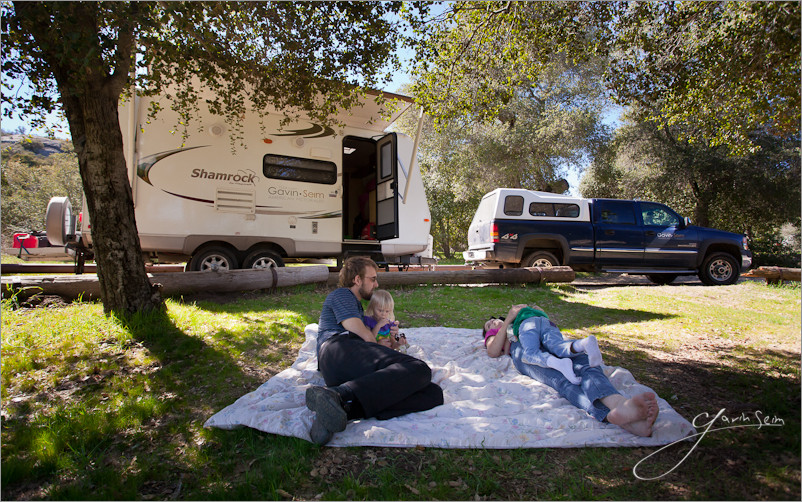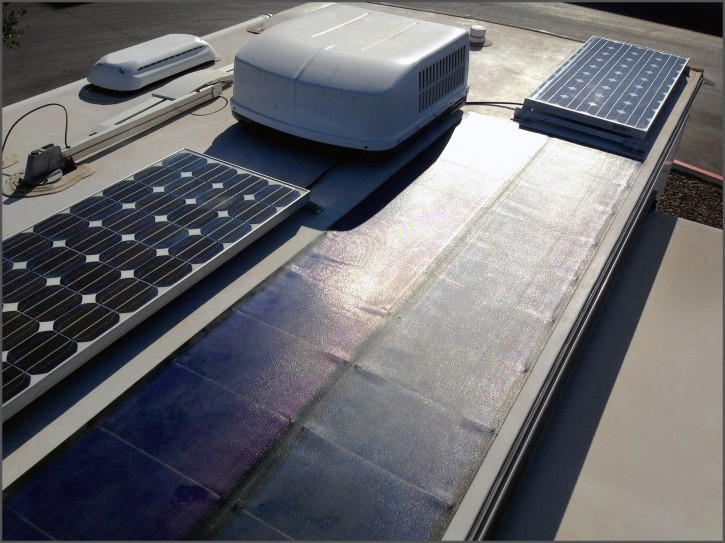![Gavin-Seim-Family-Portrait-2012]()
- A portrait of Gavin and his family by Ken Whitmire. Made while they were camped out for Wall Portrait Conference 2012. It hangs as a sixty inch print on canvas in Gavin’s living room.
A Super Campers Guide to The Galaxy!
If you’ve read stories like how we spend months on the road in a camper with our kids or seen our road trip journal, you’ll know we love Super Camping. This is about Independence exploration and taking on the world. Not loading up and heading to a resort with a pool and a waterslide. We camp in the wild for free at the most amazing places in America.
We generally do this 3-5 months a year. Traveling, exploring and working on new pictorials and films like EXposed. We usually camp off the grid in the middle of nowhere and it’s the best kind of camping. Better places, more privacy and more adventures. Here is my definition of Super Camping.
Super Camping – An independent style of camping that includes staying outside of developed campgrounds (Boondocking), usually for no cost. Super Camping generally uses a RV, tent or other rig that is prepared to function off grid with solar or battery power, food reserves, comms, medical and gear suitable for adventure, survival and mobile repairs.
How We Roll:
We load up everything we can fit including our kids into our 2011 Forest River 21SS that’s been tricked out as a boondocking machine. It’s pulled with a 2001 GMC 2500 Crew Cab 4×4 running a Duramax diesel. For those interested, this little trailer and all the upgrades we’ve installed in it runs up to about $27k. No chump change, but not much considering what we can do with it and truth told you could do it much cheaper with an older rig.
We’re compact but self sustaining with solar, extra batteries, and a generator juts in case. With this we can also run sound systems and other logistics when out speaking or doing events of the liberty trail. Combine that with water mods, good organization a rear hauling rack and the truck itself and we’re ready for the wilderness. The tanks and lines are also winter ready and we can turn on heating pads if things get chilly.
There’s nothing like finding the best places in the world to camp for free. – Boondocking in remote areas is the ticket if you want the best places. We’ve learned that sometimes you need a bit of Gypsy boldness to do this constantly. Being an activist on the side helps with that. We stay off private property without permission of course, but on public lands rules vary so you just need to learn the ropes. We research the area to which we’re going and or sometimes we just pull off on a side road and set up camp. We rarely cave to the “lets just pay for an RV park tonight” option and nearly always find a great campsite for free.
Whether it’s a photography project our out standing the line for liberty and and enhancing patriot resources, the super camper gets it done. The rest of this article is a resource that I maintain. It contains all the best resources and tools we’ve gathered over the years. From places camped to maps, gadgets and resources we use to make it go smoothly. if you want to do some Super Camping or have an RV, you’ll want to read 0n.
Super Camping Tips:
Federal lands ( National Forests, BLM, National Recreation Areas etc) are PUBLIC. As a rule they are open to free camping unless otherwise marked. In fact US Federal lands are the most consistent because they are governed by the National Recreation Act, a tidy set of rules that rangers don’t always know but you should. They are required to follow them and the National Forest has been sued and LOST for failing to do so. This is a real gem – Download, study and save a copy of the NREA.
Camping overnight in a town can be restricted, but usually you can find a Walmart or public place that’s not restricted if you just need a stopover for the night. This is where the gypsy starts to come out. You could get a knock on your door at 2AM telling you to leave. But in truth that’s never happened to us.
Scout and save. When roaming I’ll often take extra time to explore, finding and marking GPS coordinates of locations that will be good for future camping. Start building a map so you can come back to spots you discover.
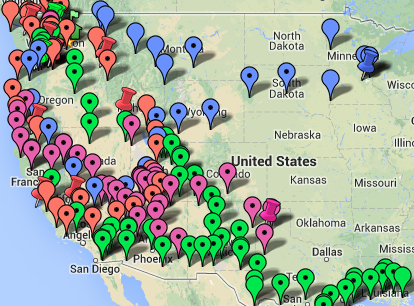
We map where we go. Most of the locations you see in the photos is on this map. It is our travels, really. I have a workflow for the maps. I save them all to a Google My Map with color pins of various types to represent the year, etc. so I can come back to the spots I’ve discovered.
The MAPS: This is our main travel map. They are very important as they show us where we’ve been, where we need to go back to and what we’ve done.
When I find or camp in a good spot I use an app that grabs my current coordinates like Right Here or GPS Location, as mentioned in the app list below. I then email myself those coordinates with a couple notes. The nice thing about this is that even if you don’t have a cell connection it will just draft the message and I’ll get later. GPS works without cell service.
When I’m settled with internet I open the coordinates in Google Maps and save the spot as a pin to a My Map Google maps in My Places. See here. Now and then I export and backup the My Map as a standard KML format file if case it ever gets nuked or I decide to use another app.
Essential Resources:
- Using a MiFi on the road, we can get internet and often pull out the laptops and phones for finding locations.
- We relentlessly make use of the Days End directory, a giant list of user submitted boondocking camp spots all over the US. It’s something you can get for a small fee if you’re a member of Escapees RV Club.
- Our Garmin GPS is also one of our essentials. Along with iPhones, apps and web pages that I’ll discuss more below.
- Google Maps is valuable. Looking at them we can find National Forests and other parks. Browsing using satellite views of the landscapes we can scout from the air. We get some amazing spots using that method, as you can find remote areas, then look for signs where people have set up camps in the past. Tire tracks, pullouts, fire rings etc. With practice you’ll get good at it.
- AccuTerra is a mobile map system that allows you to download map grids for offline use. PLUS is shows public land boundaries like BLM, DNR, etc. This covers all states, but you do have to download each sector. This is huge for finding public lands to camp on.
- Trimble GPS Hunt Pro: Is another app for iOS and Android with lots of tools, but mainly it’s a map that allows you to overlay public land boundaries on a Google map for a small fee per year. Good to have when you have internet, as it can quickly load a G map with relevant info. This one requires an internet connection (unlike AccuTerra, which can operate offline once maps are downloaded.)
- Our Travel Maps: The places we camped or scouted in the past. It’s getting big. See below for how to make them.
- SAS survival guide is a learning tool available as a book or an app. Information on nearly every emergency you might encounter. Learn survival basics.
- Gas Buddy: Saves us a lot of $$ by showing us the best fuel prices.
- GPS Location allows us to find coordinates overplayed on the map so we can route or send ourselves coordinates for later use.
- All Stays camp and RV is helpful for finding services and campgrounds when we need them.
- boondocking.org: A free website database of boondocking locations based on coordinates.
- freecampgrounds.com: A website with free or cheap camp spots. We don’t use it as much but it’s another recourse.
The Best of Tools and Gadgets:
Before we look at major camper upgrades, there’s lots of smaller things we’ve found to carry along that make thing go smoothly. In the camper we carry a plethora of resources, like extra food stores, extra water, lots of first aid stuff, chargers, batteries, toy bins for the kids and more. We cram it in. Here’s our favorites.
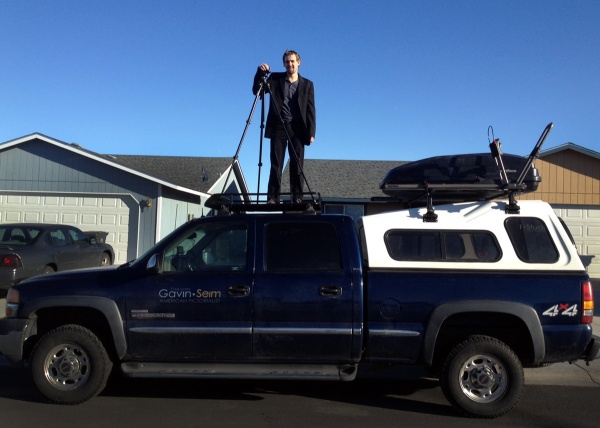
The Super Truck has lots of mods too. From a free flowing exhaust to our double Yakima Rack system. And yes, there’s a 48in photographers platform on the roof so Gavin can work stably with extra height.
First Aid: Carry a good kit. I like this big one in the camper and then carry smaller ones like this in my day pack and the truck. Then update the kits with some Celox or Quick Clot for more major Trauma in the field. Also carry an Extractor for snake bites and Water Gel creme for burns.
Radios: If you don’t have Ham radio, get a pair of FRS units. They won’t offer as much range as they say in the hills, but they give some form of communication when people are apart. We also have a Ham Radio system in the camper as well as in the pack.
Flashlights: I prefer super bright LED lights that using 18650 laptop cells and a simple charger. For a small light this X2000 is great. Cheap and really bright for the size. Way more than your average Mag light. I also like to carry a few insanely bright lights – For that, get P7 series LED light like this 900 lumen TrustFire, or something even more bright like this 1300 lumen monster. There are the brightest flashlight you have ever seen.
Road Entertainment: Of course we also load up on audiobooks for the long drives. It makes us look forward to travel.
A dash mount GPS is a great tool. Yes, our smartphones have maps, but having a dedicated unit that needs no cell connection for basic road mapping is a huge time saver.
Bear Spray: People make jokes about me carrying bear spray, but it’s no joke. When in the wilderness you can run into a wild animal or a wild person. One of these huge cans of pepper spray resides in the camper, the truck and my hiking belt at all times.
Guns: We have guns of course, but because all the foolish restrictions differ from state to state we always have bear spray in case I don’t want to carry around town. That said the camper is our castle and we generally keep a 12 gauge shotgun with buckshot in there.
Inverter: Converting power from your 12V battery system to run regular AC things like laptops and battery chargers is a must. Get a decent inverter. It will keep you from running the generator so much. You wont be running AC on this but it will keep you going. We use this 1500 watt unit.
Generator: A quality silent generator is not cheap, but it’s also valuable. Generally I‘d recommend one like a Yamaha 2000. It won’t run your AC, but it’s fairly small, will charge your system and keep you rolling without waking the dead. If you get a great solar system on your roof (200-500watts) you won’t need it much, but it’s still a valuable backup. You can of course get a larger generator that powers heat, AC and the like if size and weight are not an issue. A Yamaha or Honda 3000 is a popular choice.
Laundry Bags: Not real exciting, but laundry will build up if you’re traveling more than a few days. You’ll want a place to stow it and these help keep it tidy and easy to take to the laundromat.
Metal detector: You want things to do on the down time and this is a fun one. This Garrett Ace is probably the best bang for the buck. A decent detector for a decent price that is pretty compact.
Weather Station: Knowing what the temp is and what’s coming up is very useful. You don’t need to get crazy, but this is a nice little wireless station for a great price.
COFFEE: We are coffee people. You can carry an espresso machine on the road but some of them don”t like inverter power. To keep it simple and tasty check out the Bialetti stove top espresso machine. This thing makes a legit cup of actual pressurized espresso over a stove or fire. If you prefer a smooth drip cup check out the Hario Dripper.
25ft jumper cables: These are good for some extra power reach. A backup battery is also a good idea. That or a battery charger that you can run from your generator.
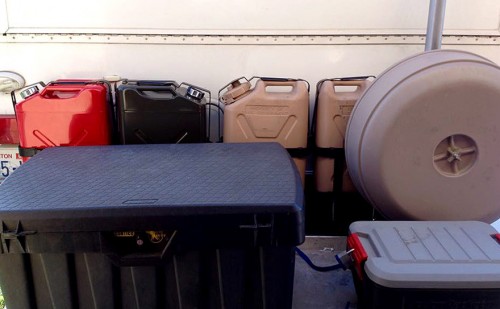
Extra water cans along with Jerry fuel cans mounted in locking brackets to the bumper.
Emergency WATER & Fuel: Water is critical for the adventurer. You can get functional 5 gallon water cans at a place like anywhere. But we use these military spec water cans, you could run these over with a truck. We also have metal Jerry fuel cans that have real spouts. All mounted in lockable brackets that are bolted to the bumper. We also have larger water reserve in the back of the truck that I’ll show you below.
Cool Tools:
- If you want to get serious about your tools this cordless reciprocating saw is amazing for cutting away branches and general work around camp. Want something a little more simple? Get a pocket chain saw like this. It works well.
- This Gerber folding shovel is rock solid and small. Don’t bother with the cheap ones. Also for a hatchet, get the Estwing. It’s the best in class.
- Compressor: A must have for us. We keep this sturdy portable unit with an extra long cord in the truck. It not only saves you time and money, it keep your tire pressure balanced. You can air down tires to 10# if you get stuck in sand. That helps you get out. Then you can air back up with this.
- A hacking blade like the Gator Machete is also useful.
- A power drill is invaluable. We love this Bosch cordless drill and it has enough power to raise the stabilizer jacks on the trailer.
- A plastic welder is a bit of a luxury, but this little guy has proved very useful for repairs on the go. We can fix almost any plastic break.
- Don’t forget a toolkit of regular hand tools. A socket set, wrenches, screwdriver and the like. We also keep a box of extra nuts, bolts and screws for repairs.
Other Good Stuff:
- We have solar on the camper, but this little 10 watt panel and a compact reserve battery is great for hiking and can charge your devices on the go.
- Don’t forget a good hunting knife for your hiking pack. Also keep 100ft of paracord on hand. It can come in handy for many things. I keep one in the camper and in the pack.
- Keep Drawers Closed: Bumpy forest roads are the bane of drawers. We’ve tried a lot of things. We finally discovered these double ball catches and all our drawers now have them. Choose your size depending on your setup. Our drawers have small clearance so we use one of the small ones on each side. They work great.
Super Camper Power System:
We have to keep everything charged and running. Even in remote areas. Solar takes care of most of our power needs. We have two UniSolar PVL 68 flexible panels. These stick directly on the roof giving a total of around 136 watts in full sun and perform better than traditional panels in shade. If you have a small camper or a curved roof these are good.
Next we added traditional silicon glass solar panels that put out around 140 watts combined. This bring us up to a total solar infrastructure of about 275 watts, or about 15 amps of charge power in full direct sunlight.
These are 12V panels running in series, which means about 24+ volts are going down the cable and into a Sun Saver TrackStar MPPT charge controller, which then converts it to the 14ish charge volts for the batteries.
We have 4 batteries mounted in two locking boxes on the front. The unit came with just one. Having more batteries has been huge and the extra power is invaluable. On a full charge we can fully run the house for days even in bad solar weather. We use the Trojan T105 golf cart style batteries. We have a total of about 450 amp-hours of 12v power.
We use power pretty heavily with computers, heater fans and the like. In fair whether and sunshine the solar pretty much keeps us ahead indefinitely. Depending on sunlight and weather, we still have to run the generator occasionally. More so if it’s sub freezing and we have to power tank heaters.
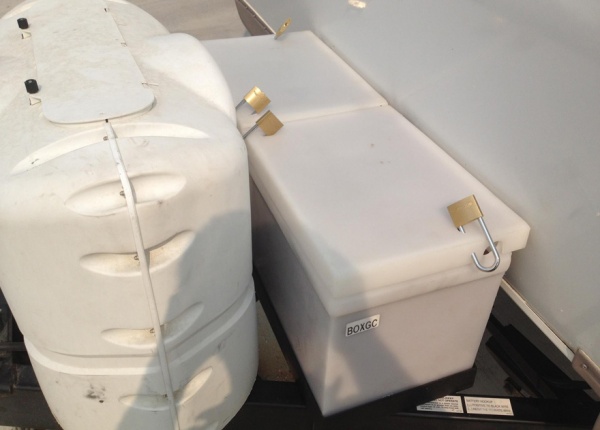
4 Trojan T105 batteries provide lots of power. We have them in these Century Plastics heavy duty battery boxes that we got from Battery Systems in Yakima. We then made a frame for them with 2 inch L metal and bolted that to the frame with sturdy U bolts. A few padlocks and we have a secure station with 4 batteries.
Not counting solar we can get a total of about 450 amp hours with the 4 T105 batteries. That means with batteries at full capacity we should be able to pull a 10 amp load for 45 hours straight. To give an example: A 13 watt light bulb in the RV would be using about 1 amp. So 10 of those running for 45 hours straight would drain us. If we didn’t have our solar.
Our generator is a Honda EU1000 as I mentioned above. These are inverter based generators and extremely quiet. They rarely disturb anyone. We plan to get a 2000 soon (Honda or Yamaha), as the 1000 is a little small for this rig and charging batteries fast.
Under the from Cabinet we have a 1500 watt inverter. This will power AC things like computers and coffee machines and microwave from the batteries without running the generator. The Cobra is not the best inverter and in time we may upgrade it, but it works pretty well.
SUPER UPGRADE: We have this inverter wired into the main power system, so even in the boondocks all the plugs work. A wire runs from the inverter to the main power box, but before it gets there we have this 30 amp AC switch that selects either shore power or inverter power. This prevents any accidents and allows the entire rig to have live power while boondocking.
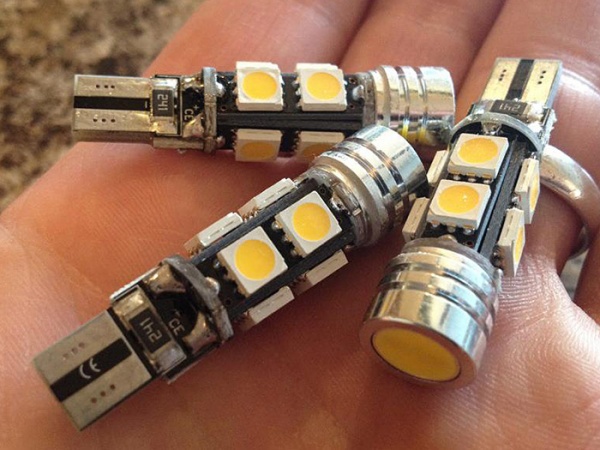
T10 Series LED lights. We get them in different sizes depending on use. They use MUCH less power. I’ve found a the warmer ones with a color temperature of about 3000 Kelvin work great. I love these 1.5 watt models.
LED Lighting: One way we conserve power for other things is by using LED lights. They use about 1/4 the power to produce the same amount of light. This means we can have plenty of light without having to worry about power.
We started by buying a few LED’s at RV supply stores. But they go at a premium. $10-30 for one light. That adds up when you have 20+ bulbs throughout. Then I did my homework. I found the same type of LED lights on eBay for just a dollar or two each. Loads of lights in every base you need at a fraction of the cost. You just have to wait a bit longer for shipping as they often come direct from China.
Out camper uses mostly the T10 series lights in the photo. Here’s some of them on eBay. The 1141/1156 are also common. Search for them here. But look around. Whatever base style you need you can probably find them. They work great, use less power and are if you shopping, I prefer the warm tone styles (around 3000K) as they are closer to traditional lights. But of you like the cooler look there’s plenty in that style as well.
Speaking of LED, there’s 8 perimeter lights mounted on the roof. We used these 10 watt LED floods and they light up the whole area. This is a very nice upgrade. I’ll add a photo in the extras.
Other Upgrades:
We have a silver blanket that goes on the tent beds for colder or hotter situations. It really helps hold in (or out) the heat, by reflecting. You can make your own, but we use a one called a Popup Gizmo. They also help keep condensation down, something that’s a common issue in tent style bunks.
We use heat pads on the holding tanks and lines. Like these. I installed these with inside a switches and turning them on keeps tanks from freezing. These are 12V, but would drain batteries pretty fast if it was really cold. Extra generator time would certainly be needed.
Rear rack: We had a hitch installed and then got a 60in aluminum rack for it. It’s rated for 500lbs. We attach the storage bins and battery boxes with bolts. They’re very secure, which is important when going up rough mountain roads. Something like this. We also tighten it up where it connects using a HitchVise or similar to make it more stable. We also use a locking hitch pin for security.
Our Espresso machine is a Bialetti stove top model. It’s nothing like the Giotto Rocket at home, but it makes a good cup on the road. We also have some manual drip coffee tools and we grind fresh using this drill modded hand grinder.
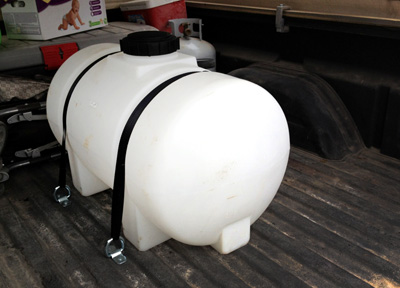
35 Gallon fresh water tank we mounted in the truck for extra water. We can draw it into the RV using the suck line.
Movie Night: We have a projector system in the camper. It uses an Optima PK301 pocket LED projector. This is no ultra bright, but on movie night or if we need a little presentation we can get a nice looking 50 inch image on our pull down screen that we can hang from the ceiling using 3m Command hooks we’ve installed.
LIGHT Control: Sometimes you want it, sometimes not. We made heavy curtains that block the light. We also made a Velcro cover for the skylight in the bathroom so I can go in at night, block out all light and load my 4×5 film.
WATER RESERVES: We mounted a 35 gallon fresh water tank in the pickup. We full this and it gives us another full tank of water. We can now go for a week or so with normal water use. This is a tank like you get at a farm store.
SAFETY & Survival:
Cautions: In remote areas, old dirt roads can go from bad to worse very quickly. Watch where you camp. Avoid low area where flash floods can occur and considering how mud or snow can effect your situation.
And when towing a trailer, turning around is not always easy. We’ve been in some scary situations. One time, it was so bad I made the family get out, and I drove down a muddy hill with the door open, ready to leap out. I really thought the car might slide off the slick mud and right over the edge. Memories… Sometimes we’ll find a flat spot to drop the trailer and then scout further up into the hills so we don’t get into a “situation.” Other times we just dive in, saying a prayer and watching out for sheer cliffs or soft sand.
First Aid: Don’t get a first aid kit after you need. it. We keep them in the pack, cars and RV, scaling up in size. Everything from basic bandages to emergency sutures. Get some kits and take the time to learn basic first aid and survival. The SAS survival guide is a great resource.
Herbs and Plants: Gaining a knowledge of herbs and plants can not only offer good food, it can save lives. Common wild herbs like Yarrow can be used to stop bleeding and help with fevers. the SAS survival guide has a good basic list. Apps like About Herbs are also useful. The Encyclopedia of Herbal Medicine is great if you want to get a bit more serious. For edible foods an app like Wild Berries and Herbs or Wild Edibles can be great.
EXTRA Photos: Because I’m running out of room.
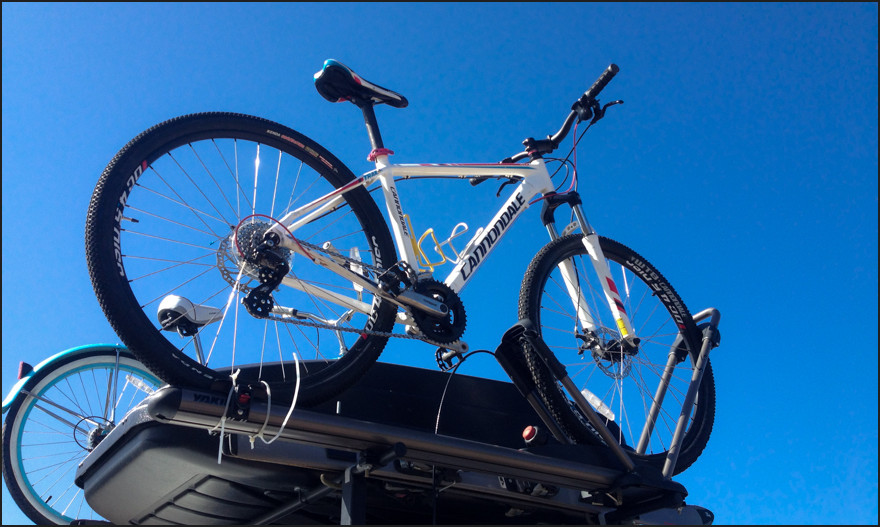
A Yakima rack system gives us lots of extra storage. Room for bikes, storage bin and even a shooting platform.
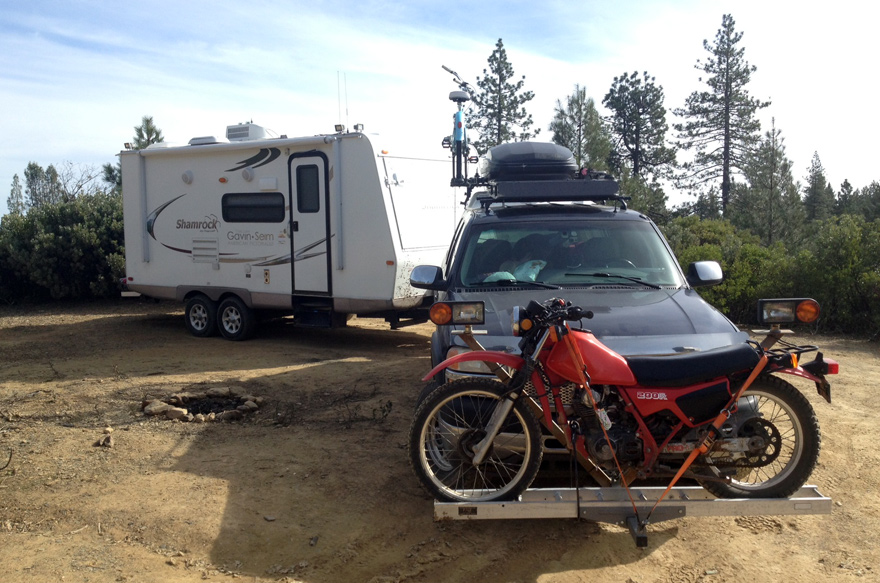
We rigged a rack to the front and carry a 200 dual sport. It gives us an extra rig and exploring tool. You need a sturdy truck for all this.

Super Camper Perimeter lighting using 10 LED floodlights.
The post A Super Campers Guide to the Galaxy appeared first on Seim - Master Photographer.
